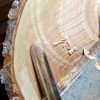Hi Gretch,
I use the Ellsworth gouge for all my bowls along with a spindle gouge to make the chuck tenon and for the final cuts on the bottom when reverse turning the almost finished bowl.
When I am starting my final wall cut. I sight down the left outside wall of the bowl. This is the line I follow on the inside of the bowl.
I do this early on in the roughing and try to rough turn a 1/2 wall maybe 2" deep. If I get an even 1/2 wall for 2 inches then cut an 1/8th inch off the wall thickness for an 1inch and a half then cut another 1/8th of the wall thickness for an inch. This should give a pretty even wall about 1/4 thick for the first inch. this wall I would check with calipers, refine and continue. I also try ti err on leaving it thicker further down.
Steep sided bowls are more difficult. A tall vase shaped natural edge bowl can look terrific and be worth the endeavor.
Try a few shallow bowls. My favorite demo size blank is a 6" diameter log cut 8" long. I round the edges. I usually turn a full inch off the bottom and the resulting bowl will be 8" long about 1.5 " high at the ends and maybe 4.5 " wide. I usually do these with out a foot.
Happy turning,
Al

